Pre-Columbian Native American Civilizations
Katie Mantooth is a writer who lives in Indianapolis, IN. She graduated from Marian University with a Bachelors in English. During her time at Marian, she worked at the Writing Center on campus where she helped run the social media and tutor at the collegiate level.
Clint has taught History, Government, Speech Communications, and Drama. He has his master’s degree in Instructional Design and Technology.
Understand pre-Columbian Native American civilizations. Learn about tribes’ cultures and facts about those who lived in America before the Europeans arrived. Updated: 01/07/2022
Table of Contents
Pre-Columbian Native Americans
It’s hard to imagine a time before the United States was a major world power. In fact, it’s hard to imagine a time when America wasn’t touched and influenced by New England settlers so long ago. Before the first explorer reached American soil, famously by Christopher Columbus in 1492, America was a land owned, harvested and cultivated by the Native American peoples. According to the Bureau of Indian Affairs, there are 574 nationally recognized Native American tribes. However, during the Pre-Columbian era, there were thought to be over 1,000 Native American civilizations, all residing within what we would consider the United States today. Pre-Columbian means before the influence of European or other cultures. Most of these groups were peaceful hunter-gatherer groups, but there were some variations based on geographical location. When studying these Pre-Columbian civilizations, they are generally grouped into North Eastern Tribes, North Western Tribes, Southwestern Tribes, Southeastern Tribes, and finally Great Plains Tribes. Native Americans built the basis on which this beautiful country was built. Their beliefs, morals, farming techniques, culture, fashion and religion shaped the history of the United States and continues to shape the culture Americans live in today. Without the structure that the Native Americans built, the United States that most love and live in today would not exist. Refer to the following subsections for a further break-down of these groups and their significances.
Native American Beadwork
Northeastern Tribes
According to the U.S. Fish and Wildlife Services, there are 25 federally recognized North-Eastern Native American tribes. These are:
- Aroostook Band of Micmac Indians
- Cayuga Nation
- Chickahominy Indian Tribe
- Chickahominy Tribe Eastern Division
- Houlton Band of Maliseet Indians
- Mashantucket Pequot Tribe
- Mashpee Wampanoag Tribe
- Mohegan Tribe of Indians
- Monacan Indian Nation
- Nansemond Indian Tribe
- Narragansett Indian Tribe
- Oneida Indian Nation
- Onondaga Nation
- Pamunkey Indian Tribe
- Passamaquoddy at Indian Township
- Passamaquoddy Tribe at Sipayik
- Penobscot Indian Nation
- Rappahannock Tribe
- Seneca Nation of Indians
- St. Regis Mohawk Tribe
- Shinnecock Indian Nation
- Tonawanda Band of Senecas
- Tuscarora Nation
- Upper Mattaponi Tribe
- Wampanoag Tribe of Gay Head
While there are currently 25 recognized tribes, during the pre-Columbian era, there were estimated to be many more. The Northeastern Tribes are considered to be any tribes who were living from the East Coast to the Mississippi River and as far south as North Carolina. This area was mainly composed of temperate forests, wetlands, and coastal zones. There were three main language groups in the Northeast areas- Algonquian, Iroquoian, and Siouan. All of the tribes in the Northeast area spoke either one or a mix of these languages. These groups were mainly agrarian, or agricultural, cultivating the land and farming skills which they would later pass on to European Settlers. They were a fairly peaceful group of tribes, honoring coalitions such as the Iroquois confederacy which was the largest coalition of tribes sharing a language and common law, but they were also known for their brutal warfare and could be ruthless if needed. However, if a member of the tribe was murdered unjustly, then revenge would be taken in the form of the death of the murderer. Socially, the Iroquois had a matrilineal society, meaning that the mother was considered the head of the household. When an Iroquois man married an Iroquois woman, he would join her and her family rather than vice versa as is generally seen in ancient societies. Often times, tribes of 100 or more people would live together in longhouses made of bark until summer, when they would migrate closer to bodies of water and live in wigwams. They are famed for their beautiful beadwork and basket making, which is still prized today. They were also skilled hunters and would trade furs for food and meat amongst tribes.
Southeastern Tribes
There are five main tribes considered to be southeastern Native American tribes during the pre-Columbian era. There are:
- Choctaw
- Cherokee
- Chickasaw
- Creek
- Seminole
These tribes were considered the five “civilized” tribes as they were the most assimilated into European society and had the most advanced economic systems. Since these groups lived in the southern area stretching from the Mississippi River to the southeast coast, they enjoyed some of the most fertile lands in the Americas. Because of this, they were skilled farmers like their northern counterparts. They were most known for farming corn, beans, tobacco and sunflowers. Like the Northeastern tribes, they were also skilled bead workers and basket-makers, particularly the Cherokee women who still use weave-patterns passed down through hundreds of generations. They were also skilled bow hunters and fishermen, often hunting deer and catfish for protein. They were also skilled at making pottery and arrowheads, which are still collected today. The southeast tribes were mainly mound-civilizations, living in huts made of mud and bark atop large dirt mounds, and were the first to utilize the “chiefdom” social system where social status was determined by proximity to the chief himself.
Southwestern Tribes
Southwestern tribes lived in what is now the dry, cavernous canyons of New Mexico, Arizona and Texas. The main tribes were:
- Pueblo
- Mogollon
- Hopi
- Hohokam
- Apache
- Navajo
- Quechan
- Havasupai
- Mojave
- Anasazi
The southwest tribes are known for their unique housing- multi-story sandstone buildings cut into the sides of canyons- and their unique irrigation methods. The Ancient Pueblo people began the tradition of carving intricate sandstone housing into the sides of canyons, but it was carried on by the Hopi who created structures that were sometimes five stories high! Since most of the Southwest area was arid, or desertous, and the tribes were mainly agrarian, the southwestern tribes created irrigation systems by digging trenches to collect rainwater which would cover and water crops such as corn or beans. The Hopi tribes are mainly credited with these systems, but the Hohokams created one of the largest irrigation systems to date. Due to the climate, these tribes also tended to be nomadic, meaning they moved around according to the seasons and the needs of their people.
Northwest Coast Tribes
The Northwestern tribes come from an area ranging from Alaska down to the Northern California coast. There were over 70 tribes in this area, but they are often grouped into four main linguistic provinces:
- The Northern Province (Tlingit, Haida, Tsimshian, and the Haida)
- The Wakashan Province (Kwakiutl, the Bella Coola, and the Nuu-chah-nulth)
- The Coast Salish-Chinook Province (Makah, Chinook, Tillamook, and the Siuslaw)
- The Northwestern California Province (Athabaskan-speaking Tututni-Tolowa, the Karok, Yurok, Wiyot, and Hupa)

An error occurred trying to load this video.
Try refreshing the page, or contact customer support.
You must c C reate an account to continue watching
Register to view this lesson
As a member, you’ll also get unlimited access to over 84,000 lessons in math, English, science, history, and more. Plus, get practice tests, quizzes, and personalized coaching to help you succeed.
Get unlimited access to over 84,000 lessons.
Already registered? Log in here for access
Resources created by teachers for teachers
I would definitely recommend Study.com to my colleagues. It’s like a teacher waved a magic wand and did the work for me. I feel like it’s a lifeline.

You’re on a roll. Keep up the good work!
Just checking in. Are you still watching?
- 0:05 A Vast Land with Many People
- 0:45 Tribes of the Northeast
- 2:19 Tribes of the Southeast
- 3:15 Tribes of the Southwest
- 5:29 Tribes of the Northwest Coast
- 6:16 Tribes of the Great Plains
Want to watch this again later?
Log in or sign up to add this lesson to a Custom Course.
These tribes, due to their proximity to the ocean, were mainly fishing and gathering tribes, but they had unique and complex cultures. The tribes were known for their huge boats created from cedar or spruce trees that could hold up to 30 people and were used to hunt otters, salmon and even occasionally whales! Many of the Northwestern Coastal tribes used totem poles to show status or to honor ancestors. Many tribes still practice this form of art today. The Chinook and Tillamook civilizations, which were from modern-day Oregon, were two of the most advanced Native American societies to exist during the pre-Columbian era because they had settled into permanent villages rather than remaining nomadic. Because of their location permanence, they were able to assign groups to jobs based on skill as well as develop a complex belief system and culture. Because these tribes were wealthy and flourishing, they often held potlatches, which were lavish feasts where chiefs often gave away or destroyed valuables as a sign of wealth and prestige.
Great Plains Tribes
The Great Plains Tribes lived in the interior plains of North America. These tribes were:
- Arapaho
- Assiniboine
- Blackfoot
- Cheyenne
- Comanche
- Crow
- Gros Ventre
- Kiowa
- Lakota
- Lipan
- Plains Apache
- Plains Cree
- Plains Ojibwe
- Sarsi
- Nakoda
- Sioux
- Tonkawa
- Arikara
- Hidatsa
- Iowa
- Kaw
- Kitsai
- Mandan
- Missouria
- Omaha
- Osage
- Otoe
- Pawnee
- Ponca
- Quapaw
- Wichita
- Santee Dakota
- Yanktonai
- Yankton Dakota
The Great Plains tribes were mainly nomadic, following buffalo herds for hunting and food. They were among the first societies on this continent to master horse-back riding in order to hunt better and move faster. The plains Native Americans used all parts of the buffalo so that nothing went to waste. They would eat the meat and use the skin and organs to create shelter, clothing and even storage bags. The bones were used for tools or jewelry. Occasionally, some of the tribes participated in agriculture but they were mainly gatherers. Many of the tribes that lived in this area, such as the Sioux actually originated in the Mississippi river valley and migrated to the plains for food and climate opportunities. The name “Sioux” was actually given to them by their enemies, but they traditionally call themselves the Dakota, Nakota, and Lakota people.
European Colonization
While Native American societies flourished before colonization, that all changed with the entrance of European settlers in 1492 and then later with the first Settlement in the 16th Century. European colonization can be defined as a time when Europeans came to America and settled on the land, imposing themselves on the Natives who lived there already. European culture was vastly different than Native American culture and due to this, Europeans often called the Natives “savages” casting them in a negative light. Almost immediately, there was warfare between the two groups as the Europeans attempted to assimilate the Natives into European culture as well as lay claim to their land. However, there are also many accounts of settlers and Natives trading with each other for fur, food, or weapons. Unfortunately, these settlers brought viruses and germs with them that were unfamiliar to the Native Americans and they proved to be deadly to nearly 90% of the Native population between 1492 and 1600. Deaths of Native Americans due to these germs were estimated to be 55 million.
Lesson Summary
During the Pre-Columbian era, meaning the time before European colonization, Native Americans thrived all over North America. Their beliefs, culture, knowledge and history is still relevant to our society today. They can be divided by geographical area into subsections such as Northwestern Coastal, Southwest, Northeast, Southeast, and the Great Plains. The Northwestern Coastal Native Americans were skilled fisherman and artists, creating many beautiful totem poles that still exist today. They were among the first natives to create permanent civilizations and often held potlatches, which were lavish feasts as a show of wealth and prestige by the chief. The Southwest Native Americans were a nomadic people who created intricate irrigation systems in order to farm. They are famed for their sandstone architecture which is often carved into the side of canyons. The Northeastern Tribes were mainly agrarian as well and migrated with the change in seasons. They also often hunted deer. The Southeastern Tribes were often referred to as the “Civilized tribes” as they were the most interested in participating in European economy and culture. However, they had a rich culture and were famed for their beadwork and basket-weaving as well as their pottery and beautiful arrowheads. The Great Plains Natives were a nomadic group, following herds of buffalo for food and supplies. They were also skilled horseback-riders. Unfortunately, this period of growth and cultivation came to an end with the entrance of European colonizers in the 16th century. Europeans brought germs and diseases which Native Americans did not have the immunity to fight and by 1600, it is estimated that 90% of the Native population had died. However, there are still many thriving tribes that still exist in North America today.
To unlock this lesson you must be a Study.com Member.
Create your account
TRANSCEND MEDIA SERVICE
TMS Is Independent Media.
No Government Grants.
No Advertising.
2022, Week 46
TMS Weekly Digest
Search TMS
To find articles by the same author, please click on the name.
Music Video of the Week
In Original Languages
Featured Research Paper
Book recommendation
Galtung’s Corner
TRANSCEND Highlights
TRANSCEND Links
Explore TMS by tags
Categories
Recent Comments
- Dr. Surya Nath Prasad on What Is Missing from the Climate Debate
- Richard Falk on TRANSCEND Members November Birthdays
- Robert Burrowes on TRANSCEND Members November Birthdays
- Marilyn Langlois on Wisdom from the Jungle
- keith willcock on New U.S. Sanctions Are Designed to Hit Nicaragua’s Poorest Citizens
Extras
Follow TMS
Before Columbus: How Africans Brought Civilization to America
On 12 Oct America’s government offices, businesses, and banks all grind to a halt in order to commemorate Columbus Day. In schools up and down the country, little children are taught that a heroic Italian explorer discovered America in 1492, and various events and parades are held to celebrate the occasion.
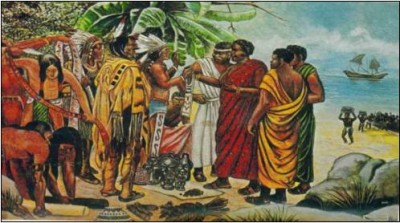
It has now become common knowledge amongst academics that Christopher Columbus clearly did not discover America, not least because is it impossible to discover a people and a continent that was already there and thriving with culture. One can only wonder how Columbus could have discovered America when people were watching him from America’s shores?
Contrary to popular belief, African American history did not start with slavery in the New World. An overwhelming body of new evidence is emerging which proves that Africans had frequently sailed across the Atlantic to the Americas, thousands of years before Columbus and indeed before Christ. The great ancient civilizations of Egypt and West Africa traveled to the Americas, contributing immensely to early American civilization by importing the art of pyramid building, political systems and religious practices as well as mathematics, writing and a sophisticated calendar.
The strongest evidence of African presence in America before Columbus comes from the pen of Columbus himself. In 1920, a renowned American historian and linguist, Leo Weiner of Harvard University, in his book, Africa and the discovery of America, explained how Columbus noted in his journal that Native Americans had confirmed that “black skinned people had come from the south-east in boats, trading in gold-tipped spears.”
One of the first documented instances of Africans sailing and settling in the Americas were black Egyptians led by King Ramses III, during the 19th dynasty in 1292 BC. In fact, in 445 BC, the Greek historian Herodotus wrote of the Ancient Egyptian pharaohs’ great seafaring and navigational skills. Further concrete evidence, noted by Dr. Imhotep and largely ignored by Euro-centric archaeologists, includes “Egyptian artifacts found across North America from the Algonquin writings on the East Coast to the artifacts and Egyptian place names in the Grand Canyon.”
In 1311 AD, another major wave of African exploration to the New World was led by King Abubakari II, the ruler of the fourteenth century Mali Empire, which was larger than the Holy Roman Empire. The king sent out 200 ships of men, and 200 ships of trade material, crops, animals, cloth and crucially African knowledge of astronomy, religion and the arts.
African explorers crossing the vast Atlantic waters in primitive boats may seem unlikely, or perhaps, far fetched to some. Such incredible nautical achievements are not as daunting as they seem, given that
numerous successful modern attempts have illustrated that without an oar, rudder or sail ancient African boats, including the “dug-out,” would certainly have been able to cross the vast ocean in a matter of weeks.
As time allows us to drift further and further away from the “European age of exploration” and we move beyond an age of racial intellectual prejudice, historians are beginning to recognize that Africans were skilled navigators long before Europeans, contrary to popular belief.
Of course, some Western historians continue to refute this fact because, consciously or unconsciously, they are still hanging on to the 19th-century notion that seafaring was a European monopoly.
After all, history will tell you that seafaring is the quintessential European achievement, the single endeavor of which Europeans are awfully proud. Seafaring allowed Europe to conquer the world. The notion that black Africans braved the roaring waters of the Atlantic Ocean and beat Europeans to the New World threatens a historically white sense of ownership over the seas.
When most people think about ancient Mexico, the first civilizations that come to mind are the Incas, Aztecs and the Maya. However, during the early 1940’s archeologists uncovered a civilization known as the Olmecs of 1200 BC, which pre-dated any other advanced civilization in the Americas.
The Olmec civilization, which was of African origin and dominated by Africans, was the first significant civilization in Mesoamerica and the Mother Culture of Mexico.
Olmecs are perhaps best known for the carved colossal heads found in Central Mexico, that exhibit an unmistakably African Negroid appearance. Ancient African historian Professor Van Sertima has illustrated how Olmecs were the first Mesoamerican civilization to use a written language, sophisticated astronomy, arts and mathematics and they built the first cities in Mexico, all of which greatly influenced the Mayans and subsequent civilizations in the Americas. “There is not the slightest doubt that all later civilizations in [Mexico and Central America], rest ultimately on an Olmec base,” once remarked Michael Coe, a leading historian on Mexico.
Africans clearly played an intricate role in the Olmec Empire’s rise and that African influence peaked during the same period that ancient Black Egyptian culture ascended in Africa.
A clear indicator of pre-Columbus African trans-Atlantic travel is the recent archeological findings of narcotics native to America in Ancient Egyptian mummies, which have astounded contemporary historians. German toxicologist, Svetla Balabanova, reported findings of cocaine and nicotine in ancient Egyptian mummies. These substances are known to only be derived from American plants. South American cocaine from Erythroxylon coca and nicotine from Nicotiana tabacum. Such compounds could only have been introduced to Ancient Egyptian culture through trade with Americans.
Similarities across early American and African religions also indicate significant cross-cultural contact. The Mayans, Aztecs and Incas all worshipped black gods and the surviving portraits of the black deities are revealing. For instance, ancient portraits of the Quetzalcoatl, a messiah serpent god, and Ek-ahua, the god of war, are unquestionably Negro with dark skin and wooly hair. Why would native Americans venerate images so unmistakably African if they had never seen them before? Numerous wall paintings in caves in Juxtlahuaca depict the famous ancient Egyptian “opening of the mouth” and cross libation rituals. All these religious similarities are too large and occur far too often to be mere coincidences.
Professor Everett Borders notes another very important indication of African presence, which is the nature of early American pyramids. Pyramid construction is highly specialized. Ancient Egypt progressed from the original stepped pyramid of Djosser, to the more sophisticated finished product at Giza. However, at La Venta in Mexico, the Olmecs made a fully finished pyramid, with no signs of progressive learning. Olmecian and Egyptian pyramids were both placed on the same north-south axis and had strikingly similar construction methods. Tellingly, all of these pyramids also served the same dual purpose, tomb and temple.
Ancient trans-Atlantic similarities in botany, religion and pyramid building constitute but a fraction of the signs of African influence in ancient America. Other indicators include, astronomy, art, writing systems, flora and fauna.
Historically, the African people have been exceptional explorers and purveyors of culture across the world. Throughout all of these travels, African explorers have not had a history of starting devastating wars on the people they met. The greatest threat towards Africa having a glorious future is her people’s ignorance of Africa’s glorious past.
Pre-Columbus civilization in the Americas had its foundation built by Africans and developed by the ingenuity of Native Americans. Sadly, America, in post-Columbus times, was founded on the genocide of the indigenous Americans, built on the backs of African slaves and continues to run on the exploitation of workers at home and abroad.
Clearly, Africans helped civilize America well before Europeans “discovered” America, and well before Europeans claim to have civilized Africa. The growing body of evidence is now becoming simply too loud to ignore. It’s about time education policy makers reexamine their school curriculums to adjust for America’s long pre-Columbus history.
Garikai Chengu is a scholar at Harvard University. Contact him on garikai.chengu@gmail.com
DISCLAIMER: The statements, views and opinions expressed in pieces republished here are solely those of the authors and do not necessarily represent those of TMS. In accordance with title 17 U.S.C. section 107, this material is distributed without profit to those who have expressed a prior interest in receiving the included information for research and educational purposes. TMS has no affiliation whatsoever with the originator of this article nor is TMS endorsed or sponsored by the originator. “GO TO ORIGINAL” links are provided as a convenience to our readers and allow for verification of authenticity. However, as originating pages are often updated by their originating host sites, the versions posted may not match the versions our readers view when clicking the “GO TO ORIGINAL” links. This site contains copyrighted material the use of which has not always been specifically authorized by the copyright owner. We are making such material available in our efforts to advance understanding of environmental, political, human rights, economic, democracy, scientific, and social justice issues, etc. We believe this constitutes a ‘fair use’ of any such copyrighted material as provided for in section 107 of the US Copyright Law. In accordance with Title 17 U.S.C. Section 107, the material on this site is distributed without profit to those who have expressed a prior interest in receiving the included information for research and educational purposes. For more information go to: http://www.law.cornell.edu/uscode/17/107.shtml. If you wish to use copyrighted material from this site for purposes of your own that go beyond ‘fair use’, you must obtain permission from the copyright owner.
One Response to “Before Columbus: How Africans Brought Civilization to America”
I appreciate the authour informing us of the fact that Europeans did not create seafaring or journeys across the oceans, and yes, there is every reason to believe that people from afar came to North America long before Columbus. What I take issue with is the assertion that African influence (Olmec civilization in particular) “was the first significant civilization in Mesoamerica and the Mother Culture of Mexico.”
Why is it so hard to find people willing to believe that Indigenous people in North and South America could possibly develop their own complex, sophisticated civilizations without influence from those across the oceans?
If there are similarities between African and Mesoamerican cultures, perhaps its because of the similarities between humans around the world, or perhaps Africans also learned from seafaring people from the Americas?
Sorry to say but this article is rife with ethnocentrism that minimizes peoples Indigenous to North and South America.
What The Americas Were Like Before Columbus Showed Up
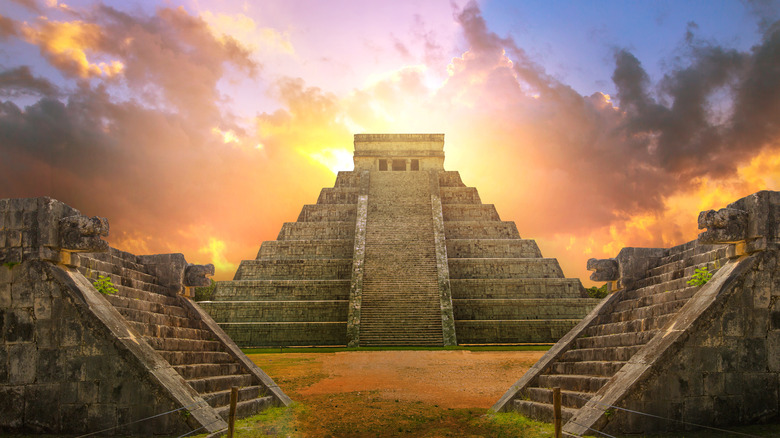
October 12 marks the day that Christopher Columbus and his crew sailed the ocean blue in search of an alternate route to East Asia and India. According to Britannica, they made landfall in the Caribbean on the Bahamas. There, they encountered a rich Pacific people called the Taino, who gave Columbus much gold and inspired Spain to begin the colonization and exploration of the landmass that would eventually be called America. But was Columbus the first person to discover America? According to the Catholic Encyclopedia, German monk Adam of Bremen had recorded the continent’s existence in the 11th century. And it was certainly far from the undeveloped, “virgin land” (via Digital History) that pervades American mythos to this day.
Before Columbus, the Americas were a diverse and fascinating place. From the Arctic regions of Canada to the Andes Mountains of South America, different types of state organizations developed among the linguistically and culturally diverse groups of Native Americans. Parts of the Americas built magnificent cities, produced luxury gold jewelry coveted by European conquerors, and perhaps even traded and interacted with other parts of the world. It is impossible to tell exactly what the Americas were like before Columbus arrived due to the continent’s diversity. Below are some more interesting and lesser known gems and tales of pre-Columbian America.
How did it start?
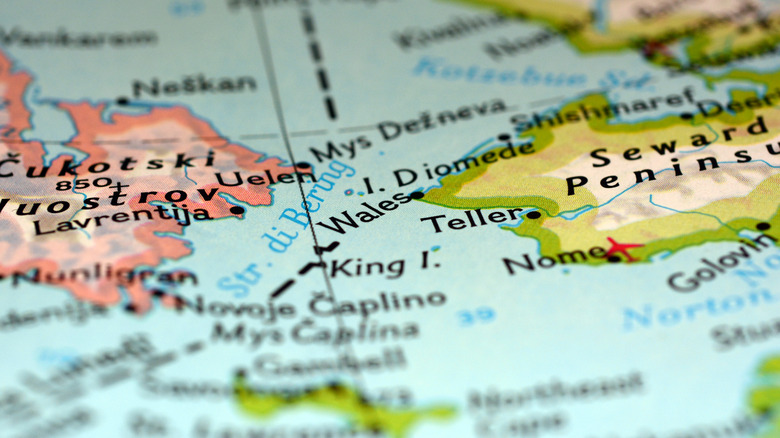
The major question regarding the Americas concerns the relations of their pre-Columbian inhabitants to the rest of the world. Surely Native American languages did not pop up in situ, and the inhabitants must have migrated from somewhere else if the Out of Africa theory of human origins is accepted. The overarching theory explaining the settlement of pre-Columbian America posits that the bulk of Native Americans descend from migrations of Ice Age hunter-gatherers, who crossed the frozen Bering Strait from modern Russian into Alaska and gradually spread throughout the continent. While VOA notes that this theory is simplistic, linguistic evidence suggests that some Native Americanss do have Siberian origins.
Linguists have, in vain, tried to find links between the numerous and sometimes isolate languages of the New World and those of Asia. But in 2008, the NY Times reported that Western Washington University professor Edward Vajda may finally have found the crucial link. Vajda connected the Na-Dene languages of Western North America and Alaska (e.g. Eyak, Tlingit, Apache, and Navajo) with the Yeniseian languages of Siberia, whose only modern survivor is the Ket language. Vajda noticed similarities in the structures of the Na-Dene and Yeniseian languages, suggesting that they most likely had a common origin that went back over 12,000 years. Unlike other attempts to link Siberia and North America, Vajda’s proposal has found acceptance in the linguistic community. If he is correct, it would confirm that at least some Native Americans came from Asia.
Polynesian partners?
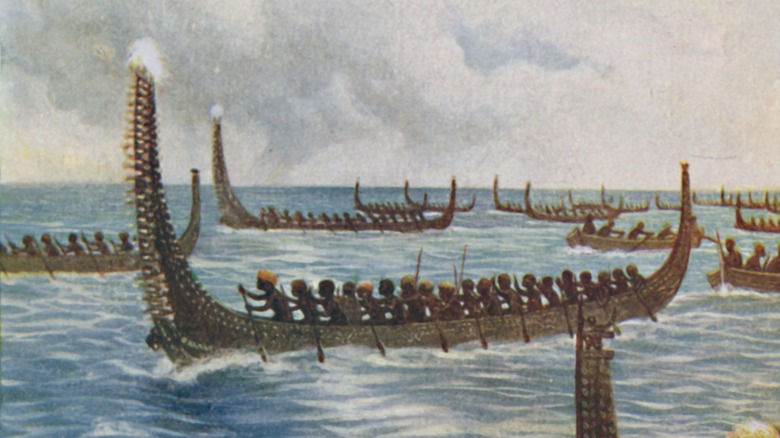
The Americas are generally considered to have been isolated from the rest of the world before 1492. But evidence from South America and the South Pacific suggests that the peoples of Columbia and Ecuador may have had contact with Polynesian seafarers who were island hopping eastward.
According to a 2013 study published in Nature, the keys to unlocking the mystery of trans-Pacific relations lay in DNA and the spread of an American holiday favorite — the sweet potato. This tuber is found in both the Americas and the South Pacific, but, according to Reuters, not anywhere else. Nature suggests that the initial spread of the sweet potato to Polynesia was the result of Polynesian seafarers visiting South America.
Smithsonian Magazine notes that Polynesian seafarers, who settled such remote locations like Hawai’i and Easter Island, were experts in their craft. They travelled thousands of miles from Pacific island to Pacific island, so there is no reason why they could not have reached the coast of South America. Now, new evidence suggests that this hypothesis is true. DNA evidence published in Nature has found pre-Columbian Native American ancestry in the inhabitants of eastern Polynesia around the 13th century. If this was indeed the case, the next question is the frequency of contact. If the hypothetical Polynesian visit to America was not a one-off isolated incident, it would suggest that the Americas were not a set of isolated continents, but part of a larger commercial system that spanned oceans.
Alaska and Asia

Further evidence for America’s connections to the world at large comes, surprisingly, from the U.S. state of Alaska. Alaska was the potential arrival point for early hunter-gatherers crossing from Siberia. Evidence of contact across the Bering Sea comes from the presence of the Yupik languages on both sides of the Bering Strait, but material evidence has been thin.
Since 2010, increased archaeological work has shown that Alaska’s natives likely were part of trade networks that stretched from Europe all the way to China and Siberia. Archaeologists excavating near Cape Espenberg (via LiveScience) discovered bronze artifacts that predated Columbus by at least 400 years. Since metalworking was unknown in Alaska, they could only have been traded down the line over the Bering Sea or the Pacific from China or Korea. This harmonizes with DNA evidence proposing that the Inuit are the descendants of a more recent migration from Asia.
The case for an East Asian connection has found further evidence from Venetian blue glass beads in Alaska. In a study published in American Antiquity, researchers dated them to the 15th century or earlier, well before Columbus. Thus, according to UAF Fairbanks, the only way they could have arrived in Alaska was from East Asia, which imported Venetian goods over the Silk Road. These findings suggest that the Alaska natives did maintain trade contacts to obtain prestige goods that they could not produce themselves. Did Alaskan elites direct this trade, was it more spontaneous, or a bit of both? Either way, it seems the Alaska natives knew more of the world beyond than previously thought, although to what degree is unknown.
Mexico was a hotbed of civilization
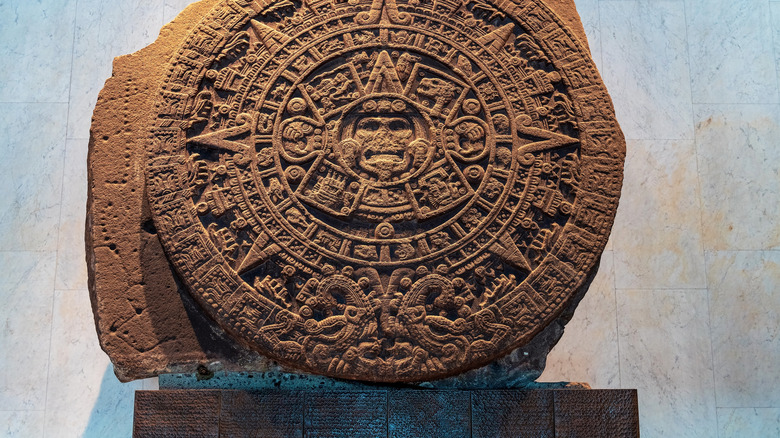
Thus far, it turns out that multiple genetic inputs contributed to the population structure of the pre-Columbian Americas. There are relatively few outside influences, however, in the continent’s major civilizations, which developed complex states and, eventually, empires as early as the 13th century B.C. Mexico was one of two major hotbeds of civilization in the Americas, and one of the richest parts of the New World.
The first complex civilization in the Americas was the Olmec culture, which appeared around 1200 B.C. in the Mexican state of Veracruz. According to History, numerous other civilizations followed, from the magnificent city of Teotihuacán to the Tarascans of Michoacán. But the jewel of pre-Columbian Mexican civilization came from the people who gave the country its name: the sophisticated but warlike Mexica people, more commonly known today as the Aztecs.
Originally from around the Utah-Arizona area, the Mexica (via Deseret News), according to their legends, migrated south into Mexico and established their capital at Tenochtitlan (modern-day Mexico City). Spanish conquistador Bernal Diaz del Castillo noted the riches of the market, which dwarfed those of Rome and Constantinople, sophisticated law courts, and, of course, the Great Temple of Tenochtitlan, located at the very center of the city. Del Castillo also noted the ubiquity of gold, which merchants used as currency in the form of dust. This was no backward, primitive world, and even the conquering Spaniards expressed a deep respect for Aztec sophistication. But there was one custom found throughout the Americas that the new arrivals found repulsive: human sacrifice.
Human sacrifice and blood rituals were facts of life
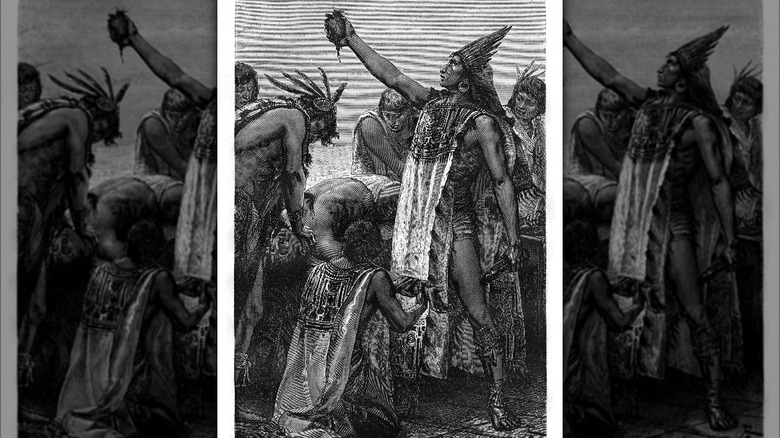
Although Native Americans are stereotyped as peaceful, pre-Columbian America was, sometimes, a violent place. A number of Native American societies practiced human sacrifice through bloody ritual killings that spanned from the United States to the Andes. According to Smithsonian Magazine, mass graves discovered from Aztalan State Park, Wisconsin to the Southern United States (via Cahokia Mounds Society) attest to the sacrifice of retainers and women in elite burials. The custom extended across the Americas, as evidenced by a mass grave from Peru containing 227 bodies (via BBC). The Encyclopedia of the Great Plains notes that the Pawnee sacrificed captive girls until the 19th century in the Morning Star Ceremony. But no one could match the Aztec Empire’s body count.
When Spanish conquistadors toured the Aztec capital, they were unprepared for the grisly scenes that awaited them. According to Bernal Diaz del Castillo, the temples smelled “worse than in a Spanish slaughter-house.” The floors and walls of the Great Temple were stained red with blood while the sacrificial platform was covered with burnt heart offerings and coagulated blood. While it might be tempting to see this as a colonialist exaggeration, archaeologists have shown that Spanish descriptions were accurate. Mexican archaeologists uncovered giant skull racks in the ruins of the Great Temple in bone-filled rooms (via Science Magazine). But there was a method to the Aztecs’ madness. According to History, human sacrifice ensured the continuation of the sun’s rising and of life itself, necessitating a continuous supply of victims. Ultimately, the conquistadors demolished the Great Temple and built Mexico City’s cathedral on it.
The Maya invented a number system with zero
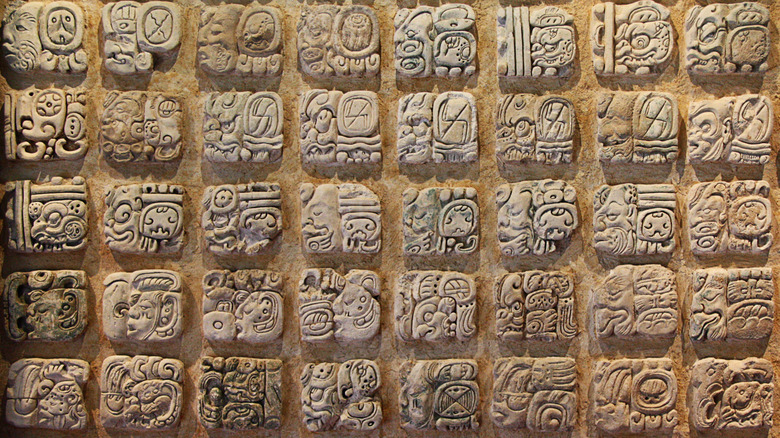
In Mexico’s Yucatan Peninsula, the Maya civilization blossomed and gave rise to a number of city states. Their cities thrived with pyramid temples that today lie abandoned in the jungles of Southern Mexico and Central America. The Maya influenced Mesoamerica’s later civilizations in astronomy, religion, and architecture. They calculated the solar year length down to three decimal places according to the Story of Mathematics, while their monuments required precise measurements and calculations to build correctly. This precision was mostly thanks to their numerical system, which was one of the most sophisticated counting systems of its time.
The Maya used a base-20 (Americans use base-10) number system of dots and lines. A dot represented one or 20 depending on its position, and lines represented five. A third symbol, a shell, represented zero. According to Scientific American, the Maya invented the idea of zero independently at a time when most of the world had no concept of zero. The use of zero made writing Mayan numbers such as 40 easy, unlike Roman numerals, whose complicated notation and lack of zero, according to SOM, made mathematical operations difficult. Thus, instead of writing XXVIII for 28, a Mayan simply wrote one dot for 20 and another group below it, representing eight. Although this achievement never spread worldwide, the independent Mayan use of zero is the biggest piece of evidence for thriving cultures of science and mathematics in the New World.
Common diseases were unknown
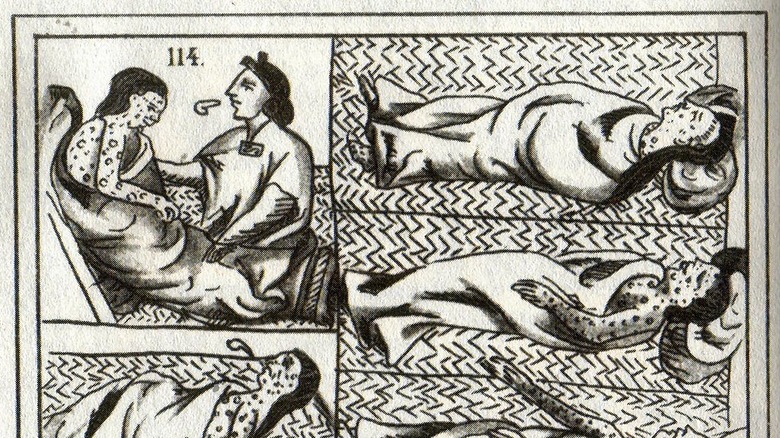
Eventually, the Americas and their great civilizations were conquered. While scholars credit European colonists’ military superiority, PBS notes that most Native Americans fell victim to disease. This is because, in pre-Columbian America, a battery of diseases that were endemic to Europe were completely unknown in the New World, and they came with devastating consequences.
According to professor Henry Dobyns (via professors Nathan Nunn and Nancy Qian), the pre-Columbian inhabitants of the New World did not suffer from (formerly) common diseases such as the flu, diphtheria, smallpox, measles, malaria, pertussis, or chickenpox. The Atlantic notes that the arrival of immune Europeans set off a wave of “virgin soil” epidemics, which first devastated the populations of Mexico and Peru and helped weaken the Inca and Aztec empires. As more Europeans arrived, the outbreaks intensified and spread throughout the Americas.
Since the Native American population had no exposure (and therefore no immunity) to Old World diseases, their population collapsed. Professors Nunn and Qian estimate that around 95% of the indigenous population of the Americas perished from disease by the mid-17th century. According to Smithsonian Magazine, entire populations such as the Taino of modern Hispaniola disappeared as distinct entities, and the survivors intermarried with Spanish arrivals and African slaves. But as the Microbiology Society notes, the native populations of America did return Columbus and his successors the favor. Among the diseases that were introduced to Europe was a venereal disease called the “Great Pox,” better known today as syphilis.
There were no horses
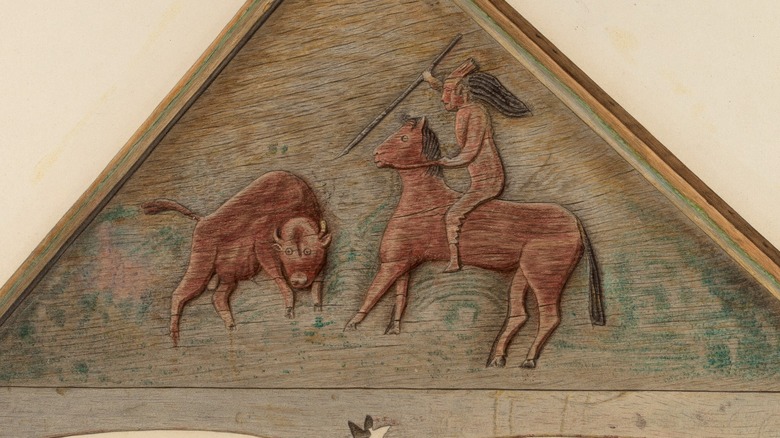
The image of mounted Native American warriors riding across the Great Plains on buffalo hunts pervades popular imagination. But the association of Native Americans with horses is a relatively recent one because before 1492, there were no horses in the Americas. LiveScience notes that the last native species of North American horse went extinct around 9,000 B.C. According to History, the Native Americans of the sparsely-populated pre-Columbian Great Plains had to adapt to life without horses. Buffalo meat was plentiful, but buffalo hunting was a dangerous task, especially on foot. Because of their size, hunters crippled buffalo, usually by running them off a cliff, before killing them, and success was fleeting. According to Britannica, early Plains cultures had to supplement hunting with small-scale agriculture to survive.
Columbus re-introduced horses to the Americas in 1493 with a herd of 24 animals. As horses spread, the Native Americans of the Great Plains incorporated the animal into their lives. Mounted warriors could hunt buffalo at less risk to themselves. Thus, according to WNET 13, the horse enabled the settlement of the Great Plains. The diet of the Great Plains Native Americans shifted primarily to buffalo meat, and some phased out agriculture entirely. The Comanche are the best example of this shift, leaving the Rocky Mountains to emerge on the Great Plains as the epitome of the Plains mounted warrior. Their merciless raids against fellow tribes and American settlers made them legendary in the lore of the wild west. None of this would have been possible without their hardy and fast mustangs.
Greenland: two worlds collide
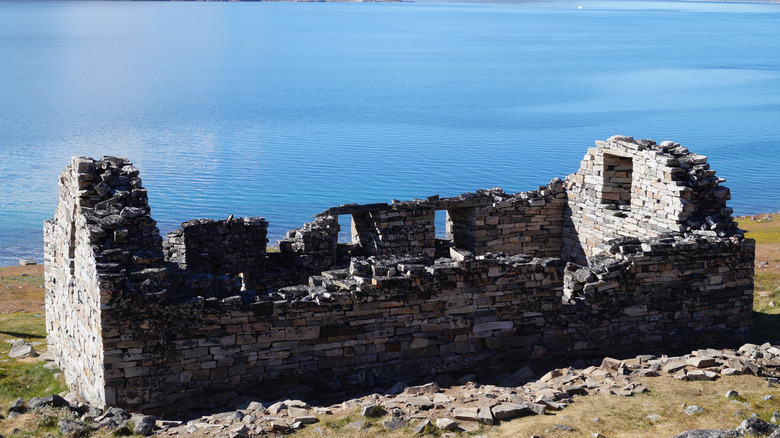
Well before Columbus, another set of Europeans had already found its way to the American continent. According to the BBC, the Vikings were prolific traders and explorers navigating as far as Central Asia using the rivers of Eastern Europe. But they also reached the Americas. Their most famous settlements were on the virgin island of Greenland, which, according to Visit Greenland, is geologically part of the American continent and hosted the first encounters between Native Americans and Europeans.
According to Smithsonian Magazine, Viking expeditions beginning with Erik the Red settled Southern and Western Greenland, creating thriving economies based around animal husbandry and walrus ivory. Norse hunters trekked to the west coast of Greenland to procure the ivory, which made the colonies rich and enabled the creation of beautiful artworks like the Lewis Chessmen. The St. Nicholas Cathedral, built in the 12th century and one of the oldest cathedral buildings in the Americas, is a testament to Greenland’s prosperity. But sadly, the good times did not last.
Around 1200, Canadian Geographic notes that the Inuit appeared in Greenland. According to the Christian Science Monitor, these whale- and-seal-hunting nomads lived alongside the Norse (whom they called Kavdlunait) and occasionally traded with them. But they did not intermarry and, according to Inuit tales such as the Legend of Ungortok, even fought each other. In the end, the Inuit won out, and the Norse abandoned their settlements as the climate cooled. When Norwegian missionary Hans Egede looked for his long-lost kin in 1721, all that was left were the crumbling remains of once-beautiful buildings of the New World’s first Europeans.
Precision stonework: an Andean specialty
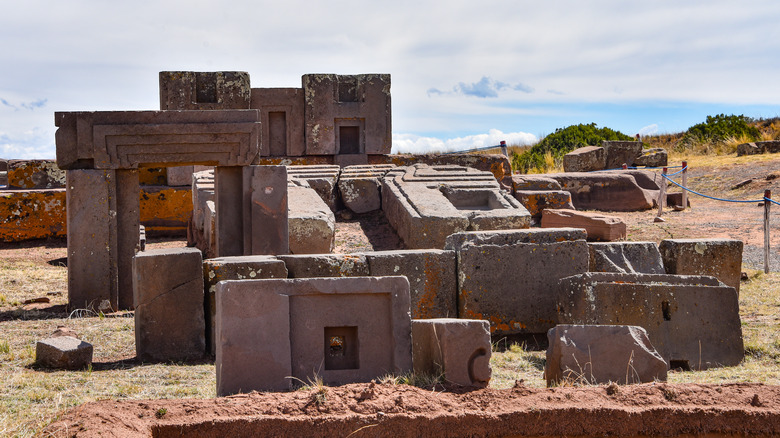
Before Europeans arrived, the great states of the New World were already building monumental stone architecture. The Inca Empire is best known for its magnificent cities like Macchu Picchu, engineered on the difficult terrain of the Andes. But they learned to do that from their predecessors — the Tiwanaku – who engineered a city that has secured its place in the popular imagination for its size and precision.
According to the Washington Post, Puma Punku is a megalithic pyramid that was built with stones quarried from miles away. Some of them weighed up to 160 tons. Yet, the inhabitants of Puma Punku did not have the wheel, so how exactly they hauled such stones to the city is a matter of debate. Archaeologists can only speculate. The dominant theory posits that stones were rolled on wooden logs. But how they cut them so precisely that not even a razor blade could fit between them is a mystery. According to LiveScience, there is no evidence for writing in Tiwanaku, making the question all the more fascinating.
Puma Punku’s aura of mystery has also inspired fringe theories claiming that aliens aided in the city’s construction. History’s Ancient Aliens claims that it would have been difficult for humans, even today, to build a site so precisely and on such a large scale. But perhaps that is a sign that these Andean societies were far more advanced than modern scholarship gives them credit for.
Are the legends true?
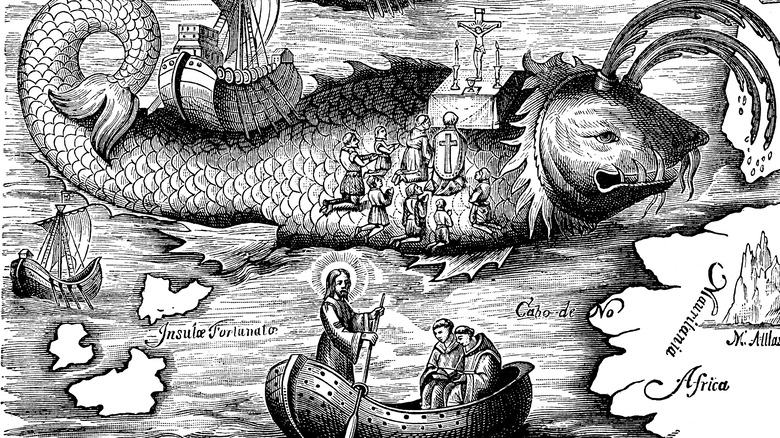
Could others have reached America before Columbus? Norse Greenlanders briefly settled Canada in at least one place, L’Anse aux Meadows, around 1000. But according to Irish legend (via Irish Central), the abbot St. Brendan the Navigator equipped a small Irish oxhide boat and sailed west 500 years earlier. According to Chapter 28 of the Voyage of St. Brendan, the crew explored a rich land across the ocean before returning home to Ireland. But was it true, or just symbolic?
Scholars originally deemed St. Brendan’s voyage an impossible endeavor, but Tim Severin (via Irish Times) proved otherwise in 1976. Norse legends, according to Indian Country Today, support it. The Saga of the Eyrbyggja (via “The discovery of America by the Northmen, in the tenth century”), tells how Norseman Gudleif Gudlaugson was blown off course and reached an unknown western land whose inhabitants spoke an Irish-sounding language. Danish historian and linguist Carl Rafn concluded that it was “Great Ireland,” a land south of the Norse settlements of Vinland (Newfoundland). Rafn, however, also claimed that these settlers left a mark in the Shawnee tribe’s oral histories, which allegedly described white-skinned tribes wielding metal tools.
If true, it would mean that Christianity arrived in the New World well before Columbus. As Texas State University professor Kent Reilly notes, anything is possible, but there is no hard evidence outside of legend. In fact, according to the LA Times, most scholars have rejected it as pure fantasy. It is unlikely that the legends were invented, however, so until more evidence is available, it is up to readers to decide on the veracity of these bombshell claims for themselves.
Source https://study.com/learn/lesson/native-american-civilizations-pre-columbus-tribes-facts-cultures.html
Source https://www.transcend.org/tms/2018/10/before-columbus-how-africans-brought-civilization-to-america/
Source https://www.grunge.com/670314/what-the-americas-were-like-before-columbus-showed-up/